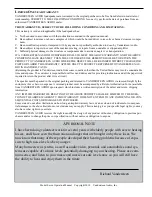
V
ANDERSTEEN
A
UDIO
12
G
UIDE
T
O
A
DJUSTING
T
HE
R
OOM
C
OMPENSATION
C
ONTROLS
.
8. Play tracks sixteen through twenty six (right channel)
and verify two thirds are above 70dB and one third
below. It most likely will not be, so adjust the low
frequency level on the right speaker’s amplifier up or
down until two thirds are above and one third are be-
low. Do not change this setting until finished with the
calibration procedure. Note: this is on the right
speaker not the preamp which remains as set earlier.
9. Play tracks sixteen through twenty six again and note
on the Work Sheet how far each band is above or be-
low 70dB. For example:
dB +6 -3 -4 0 +4 +10 +2 +6 +10 -3 +2
(Note: that two thirds are up and a third are down. If
the reading is off the scale, call it +10 or –10 as be-
fore).
10. Calculate the target correction by multiplying by .3
and rounding to the next greater whole number. For
example using the right channel noted above:
dB +2 -1 -2 0 +2 +3 +1 +2 +3 -1 +1
(Note: if the pot stops full counter clockwise or
clockwise before attaining your target number this is
OK, leave it there do not force the pot as they are frag-
ile).
11. Repeat #10 for the target calculation for the left chan-
nel.
12. Play track one and have an assistant adjust pot #1 on
the left speaker to the previously calculated target or
all that is possible within the range of the pot.
13. Repeat #12 for each appropriate track and pot.
The Model Seven amplifier levitates the subwoofer cone and centers the voice coils.
If the subwoofer amplifier has been unplugged for more than a few hours - includ-
ing when the speakers are first set-up - avoid playing deep bass above a moderate
conversational level until the amplifier has been plugged-in for at least one hour to
allow the subwoofer driver to center. Never float the subwoofer ground!
L
OW-
F
REQUENCY
ROOM
O
PTIMIZATION
The eleven room compensation controls located on the
rear input plate help counter the amplitude and phase effects
of room nodes and anti-nodes and provide the most linear
low frequency response at the listening position. They can
only be properly set by using the Vandertones disk and a
Radio Shack analog S.P.L. meter. Once the controls have
been set for a particular room, they should not need to
be readjusted unless the speaker placement and/or lis-
tening position are significantly changed.
The low-frequency level will be set by the process
on page 13.
1. Set the microphone at the listening position at ear
height.
2. Turn on the S.P.L. Meter to the 70dB scale, “C”
weighting, “Slow” response.
3. Insert Vandertones test disc into a CD player, set the
volume on the preamp to a low level.
4. On the left Model Seven sub-woofer amplifier set the
low frequency contour control to minimum (#1) and
verify that all eleven room compensation bands are set
straight up (screwdriver slot vertical). Set low fre-
quency level to 0dB.
5. Locate the Low Frequency Work Sheet provided loose
in this manual. Make copies if necessary and keep one
as a master.
6. Play tracks one through eleven (left channel) and note
on the Work Sheet the meter readings for all eleven
tracks. Adjust the preamp volume up or down until
two thirds of the tracks read 70dB or higher and one
third of the tracks are 70dB or lower. This is your
reference volume. Do not readjust until this entire cali-
bration is complete for both speakers.
7. Play tracks one through eleven again and note on the
Work Sheet how far each band is above or below
70dB. For example:
dB 0 +4 –10 +10 +6 –4 +10 +3 +6 –6 +3
(Note: that two thirds are up and a third are down. If
the reading is off the scale, call it +10 or –10).
A
DJUSTMENT
S
ECTION
WITH VANDERTONES DISK AND RADIO SHACK S.P.L. METER
This procedure requires the Radio
Shack analog S.P.L. meter (digital will
not give satisfactory results) and the
Vandertones test disk. Do not use any
of the commonly available frequency
correction charts or a meter that has
been modified to be corrected.




















